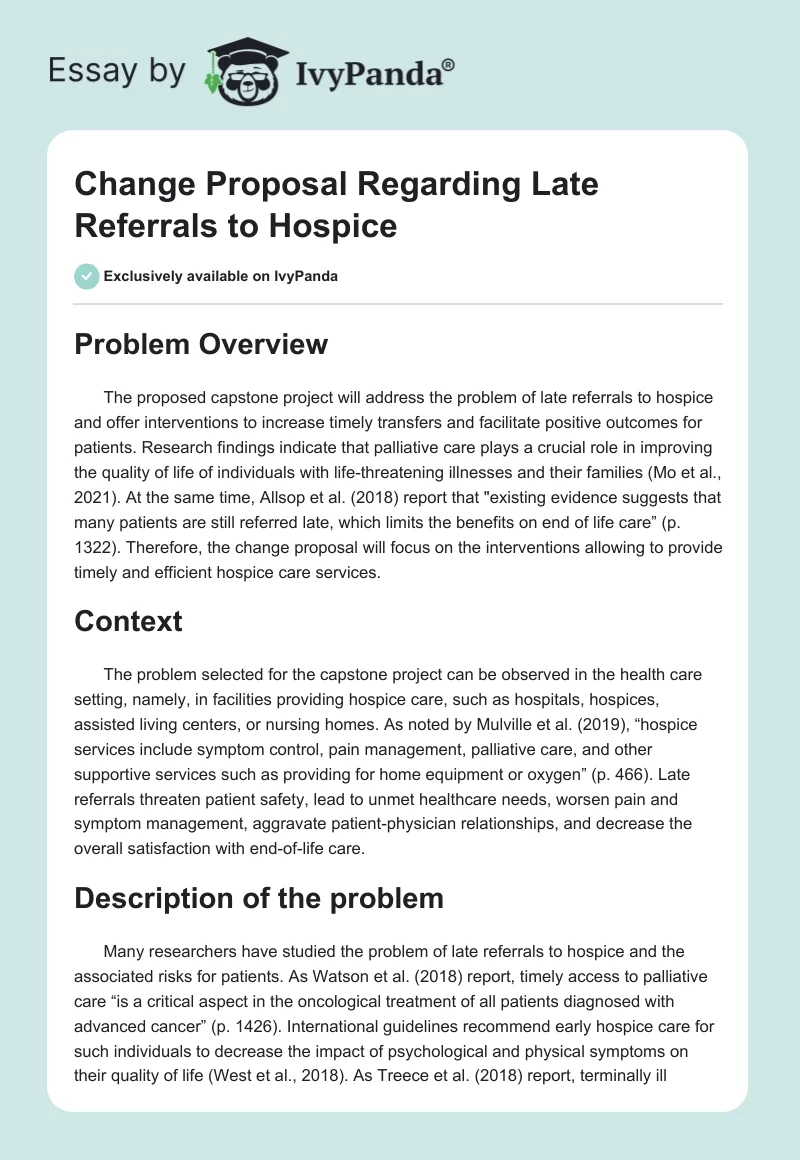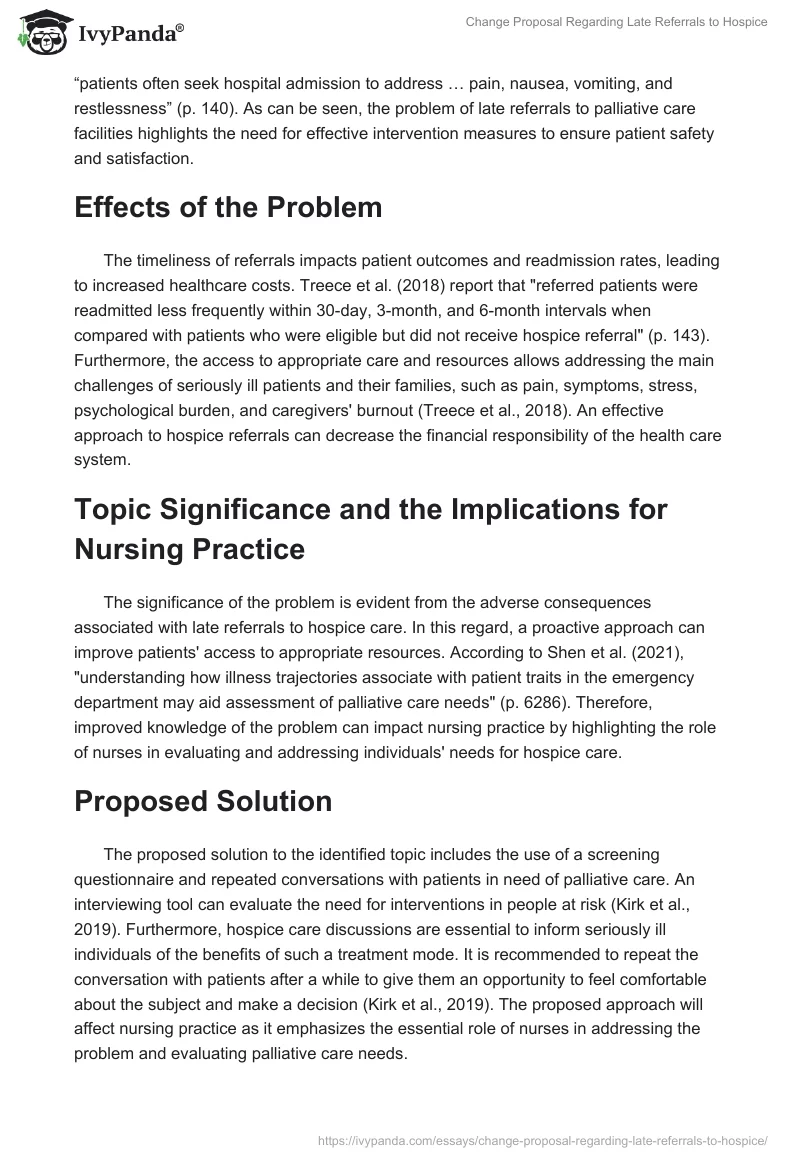Problem Overview
The proposed capstone project will address the problem of late referrals to hospice and offer interventions to increase timely transfers and facilitate positive outcomes for patients. Research findings indicate that palliative care plays a crucial role in improving the quality of life of individuals with life-threatening illnesses and their families (Mo et al., 2021). At the same time, Allsop et al. (2018) report that “existing evidence suggests that many patients are still referred late, which limits the benefits on end of life care” (p. 1322). Therefore, the change proposal will focus on the interventions allowing to provide timely and efficient hospice care services.
Context
The problem selected for the capstone project can be observed in the health care setting, namely, in facilities providing hospice care, such as hospitals, hospices, assisted living centers, or nursing homes. As noted by Mulville et al. (2019), “hospice services include symptom control, pain management, palliative care, and other supportive services such as providing for home equipment or oxygen” (p. 466). Late referrals threaten patient safety, lead to unmet healthcare needs, worsen pain and symptom management, aggravate patient-physician relationships, and decrease the overall satisfaction with end-of-life care.
Description of the problem
Many researchers have studied the problem of late referrals to hospice and the associated risks for patients. As Watson et al. (2018) report, timely access to palliative care “is a critical aspect in the oncological treatment of all patients diagnosed with advanced cancer” (p. 1426). International guidelines recommend early hospice care for such individuals to decrease the impact of psychological and physical symptoms on their quality of life (West et al., 2018). As Treece et al. (2018) report, terminally ill “patients often seek hospital admission to address … pain, nausea, vomiting, and restlessness” (p. 140). As can be seen, the problem of late referrals to palliative care facilities highlights the need for effective intervention measures to ensure patient safety and satisfaction.
Effects of the Problem
The timeliness of referrals impacts patient outcomes and readmission rates, leading to increased healthcare costs. Treece et al. (2018) report that “referred patients were readmitted less frequently within 30-day, 3-month, and 6-month intervals when compared with patients who were eligible but did not receive hospice referral” (p. 143). Furthermore, the access to appropriate care and resources allows addressing the main challenges of seriously ill patients and their families, such as pain, symptoms, stress, psychological burden, and caregivers’ burnout (Treece et al., 2018). An effective approach to hospice referrals can decrease the financial responsibility of the health care system.
Topic Significance and the Implications for Nursing Practice
The significance of the problem is evident from the adverse consequences associated with late referrals to hospice care. In this regard, a proactive approach can improve patients’ access to appropriate resources. According to Shen et al. (2021), “understanding how illness trajectories associate with patient traits in the emergency department may aid assessment of palliative care needs” (p. 6286). Therefore, improved knowledge of the problem can impact nursing practice by highlighting the role of nurses in evaluating and addressing individuals’ needs for hospice care.
Proposed Solution
The proposed solution to the identified topic includes the use of a screening questionnaire and repeated conversations with patients in need of palliative care. An interviewing tool can evaluate the need for interventions in people at risk (Kirk et al., 2019). Furthermore, hospice care discussions are essential to inform seriously ill individuals of the benefits of such a treatment mode. It is recommended to repeat the conversation with patients after a while to give them an opportunity to feel comfortable about the subject and make a decision (Kirk et al., 2019). The proposed approach will affect nursing practice as it emphasizes the essential role of nurses in addressing the problem and evaluating palliative care needs.
References
Allsop, M. J., Ziegler, L. E., Mulvey, M. R., Russell, S., Taylor, R., & Bennett, M. I. (2018). Duration and determinants of hospice-based specialist palliative care: A national retrospective cohort study.Palliative medicine, 32(8), 1322-1333. Web.
Kirk, M. A., Hanson, L. C., Weinberger, M., Haines, E. R., Rokoske, F. S., Powell, B. J., & Birken, S. A. (2019). Pilot test of an adapted intervention to improve timeliness of referrals to hospice and palliative care for eligible home health patients.Journal of palliative medicine, 22(10), 1266-1270. Web.
Mo, L., Urbauer, D. L., Bruera, E., & Hui, D. (2021). Recommendations for palliative and hospice care in NCCN guidelines for treatment of cancer. The oncologist, 26(1), 77-83. Web.
Mulville, A. K., Widick, N. N., & Makani, N. S. (2019). Timely referral to hospice care for oncology patients: A retrospective review.American Journal of Hospice and Palliative Medicine, 36(6), 466-471. Web.
Shen, V. W. C., Yang, C., Lai, L. L., Chen, Y. J., Huang, H. H., Tsai, S. H., Hsu, T. F., & Yen, D. H. T. (2021). Emergency department referral for hospice and palliative care differs among patients with different end-of-life trajectories: A retrospective cohort study.International Journal of Environmental Research and Public Health, 18(12), 6286. Web.
Treece, J., Ghouse, M., Rashid, S., Arikapudi, S., Sankhyan, P., Kohli, V., O’Neill, L., Addo-Yobo, E., Bhattad, V., & Baumrucker, S. J. (2018). The effect of hospice on hospital admission and readmission rates: A review. Home Health Care Management & Practice, 30(3), 140-146. Web.
Watson, G. A., Saunders, J., & Coate, L. (2018). Evaluating the time to palliative care referrals in patients with small-cell lung cancer: A single-centre retrospective review.American Journal of Hospice and Palliative Medicine, 35(11), 1426-1432. Web.
West, T. D., Galicia-Castillo, M. C., Cadieux, C. P., & Parks-Savage, A. (2018). Hospice care needs study.American Journal of Medical Quality, 33(4), 443-445. Web.


